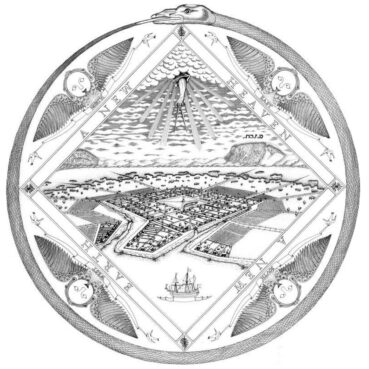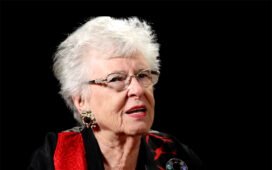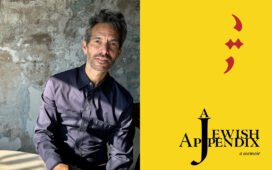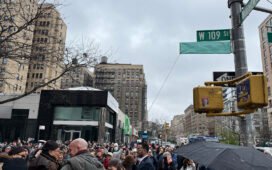NEW HAVEN, Conn. (RNS) — Twelve years ago, just before Halloween, a skeleton rose out of the ground of the town green in New Haven. Hurricane Sandy had just whipped through the region, soaking the soil. The Lincoln Oak, planted on the green in 1909, swayed in the wind, then toppled over. Massive roots came up as the giant fell. Passersby saw a chilling sight caught in the roots: a long white bone; a ribcage; the back of a human skull. By nightfall of Halloween eve, the New Haven police and a forensic investigator had arrived on the scene.
Thankfully, these remains weren’t from a recent homicide; the unearthed skeleton was one of the estimated thousands of bodies still beneath the green from the time it had served as a burial ground, from the founding of the city in 1638 until 1821. The headstones were moved to nearby Grove Street Cemetery but the bodies remained.
While not evidence of a crime, the bodies under the green pointed to something mysterious, even mystical. The New Haven Green has long been haunted by the rumor that it was meant to fit 144,000 bodies that would rise from the dead on the Day of Judgment, in the last days of the world. This prophecy is based on a passage from the Book of Revelation, the last book of the Christian Bible.
In fact, historic city plans show that its Puritan founder, John Davenport, likely built New Haven to be a replica of an apocalyptic holy city of God. The measurements for his original square city plan match those of the temple in the vision of Ezekiel in the Bible. The nine-square city grid also mimics the walls and gates of the heavenly New Jerusalem of Revelation (three gates on each side of the square, making 12 gates total, representing the 12 tribes of Israel).

New Haven Colony around 1640 by Erik Vogt. (Image courtesy of Creative Commons)
Like other Puritan leaders arriving in the American Colonies, Davenport believed communities in New England to embody God’s heavenly city, metaphorically and literally, as we can see from his apocalyptic urban planning.
This understanding of America and the United States as God’s city, the New Jerusalem, has only grown through the centuries. It is part of the American origin myth of “pilgrims” arriving in a promised land, a holy place. It continued through western expansion, which, when the United States reached the West Coast, marked the U.S. as the place where the New Jerusalem was to rise.
In an echo of the New Jerusalem description in Revelation, Ronald Reagan described the U.S. as a “proud city built on rocks stronger than oceans, wind-swept, God-blessed, and teeming with people of all kinds living in harmony and peace.” Donald Trump shared his vision of the U.S.-Mexico border being delineated with a “beautiful wall” that is “see-through,” with a “big, beautiful door,” defending the country against invaders, mimicking — intentionally or not — the vocabulary in Revelation describing the clear-as-crystal walls and pearly gates of the New Jerusalem.
Likening the U.S. to the heavenly city gives the country a golden glow of righteousness and paints it as a paradise. But God’s heavenly city also has its enemies, described in Revelation as “dogs and sorcerers and sexually immoral and murderers and idolaters and everyone who loves and practices falsehood.” These are the ugly terms also used by leaders throughout American history against immigrants they have wanted to keep out, calling them “animals,” claiming they are violent, godless and especially diseased.
Skeletons buried beyond the perimeter of the New Haven Green tell a different story than the Puritan vision of the “chosen” living in God’s city. In 2011, the year before the skeleton popped up on the green, construction workers found four skeletons while digging the site of a Yale-New Haven Hospital project, just southwest of the green. These came from burials from the 1830s until the 1850s, when the site was a graveyard for a Catholic church.
The skeletons appear to belong to an Irish immigrant and three others of eastern or southern European descent, all bearing the marks of a hard life. Catholic Irish immigrants had been ostracized in the 19th century as following the anti-Christ (the pope) and bearing the mark of the Beast, also a figure from Revelation. Long-standing prejudice against eastern and southern Europeans was reflected in the Immigration Act of 1924, greatly restricting immigrants from those regions, as versus immigrants from northern Europe.
The corpses of other immigrants were not buried but shipped back to where they came from. In 1870, the Elko Independent, a Nevada newspaper, reported on shipments of dead Chinese railroad workers: “We understand that the Chinese companies pay the Railroad Company ten dollars for carrying to San Francisco each dead Chinaman. Six cars, well stuffed with this kind of freight, will be a good day’s work. The remains of the females are left to rot in shallow graves.”
By 1875, the first anti-Chinese immigration law was passed, followed by a series of others until all Chinese (and other Asians) were barred from immigrating to the U.S.
Since the mid-1990s, more than 4,000 bodies have been found in the Sonoran Desert of Arizona. A record of their deaths can be found in the display of orange and yellow corpse toe-tags, pinned to a map that is part of the traveling exhibition “Hostile Terrain 94.” Along with the bodies in the desert were found children’s toothbrushes, shoes and toys, all belonging to travelers hoping to cross the border.
These are currently the human beings unable to enter and live in what was envisioned as God’s heavenly city. It is time to reenvision the U.S., not as a city with walls and invading enemies, but part of a world together facing climate change and conflicts that must be resolved.















